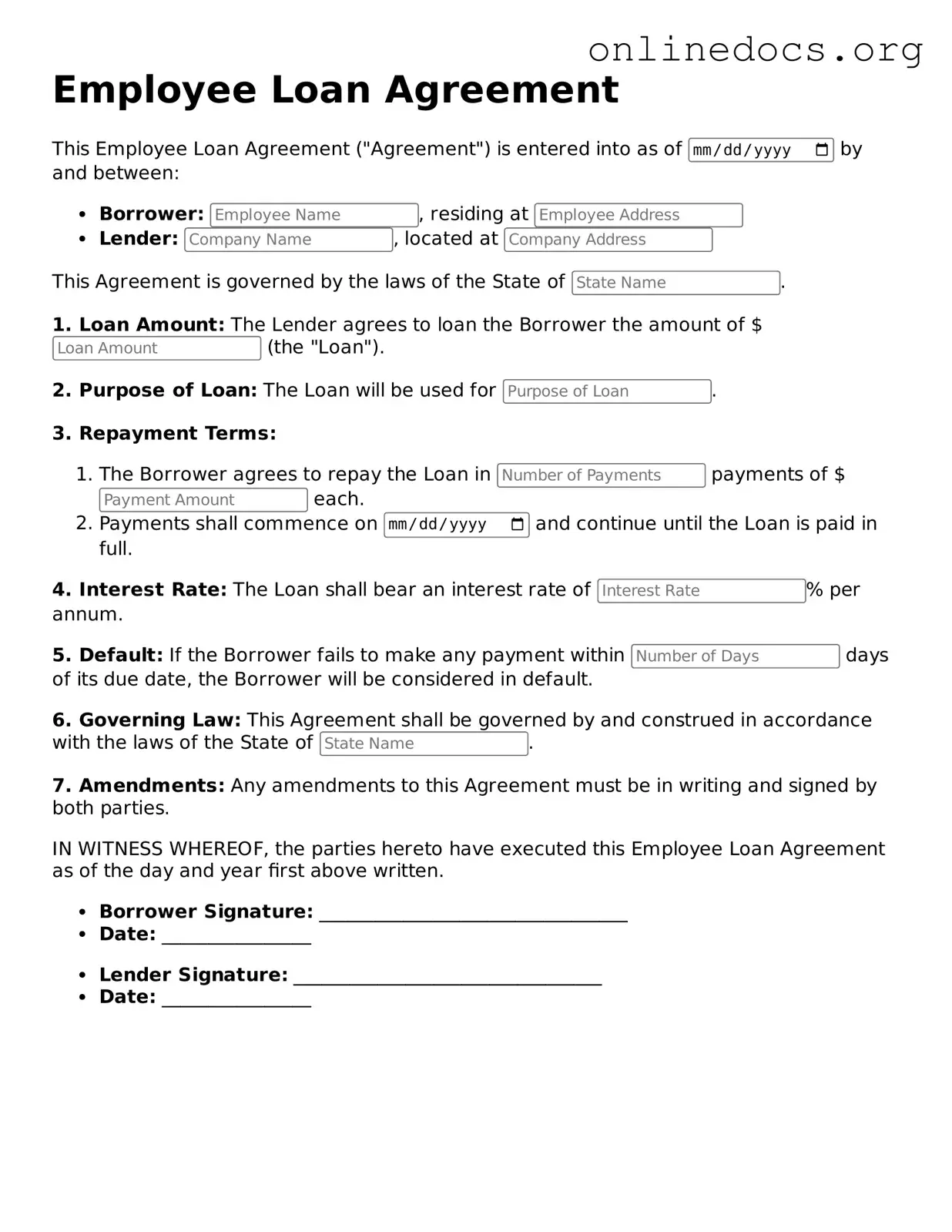The Employee Loan Agreement form is similar to a Personal Loan Agreement. Both documents outline the terms and conditions under which one party lends money to another. They typically include details such as the loan amount, interest rate, repayment schedule, and consequences for default. This ensures that both the lender and borrower have a clear understanding of their rights and responsibilities, fostering transparency in the lending process.
Another document akin to the Employee Loan Agreement is the Promissory Note. A Promissory Note is a written promise to pay a specified sum of money to a designated party at a particular time or on demand. While it may not detail the terms as extensively as an Employee Loan Agreement, it serves a similar purpose by creating a legally binding obligation for repayment. Both documents protect the interests of the lender while providing the borrower with a clear outline of their repayment obligations.
The Loan Application form shares similarities with the Employee Loan Agreement as well. While the Loan Application is primarily used to assess the borrower's creditworthiness and financial situation, it often leads to the creation of a loan agreement. Both documents require the borrower to provide personal and financial information, ensuring that lenders can make informed decisions before extending credit.
A Credit Agreement is another document that resembles the Employee Loan Agreement. This type of agreement outlines the terms of a credit arrangement between a lender and a borrower, which may include lines of credit, credit cards, or other forms of borrowing. Both documents specify the repayment terms and conditions, as well as the rights of both parties, ensuring clarity and mutual understanding.
In addition, a Mortgage Agreement has similarities to the Employee Loan Agreement. While a mortgage specifically pertains to loans secured by real estate, both documents establish the terms of a loan, including interest rates, repayment schedules, and default consequences. They both serve to protect the lender's interests and provide borrowers with a clear framework for repayment.
In considering various financial agreements, the significance of a clear and binding document cannot be overstated. Whether it's a Loan Agreement or a related document, each serves to protect the interests of both parties involved. For examples of templates that can help create these agreements with precision, you can visit smarttemplates.net, which provides valuable resources for drafting various types of contracts to ensure mutual understanding and clarity.
The Lease Agreement is another document that bears resemblance to the Employee Loan Agreement. While primarily used for renting property, a lease agreement often requires a security deposit or advance payment, much like an employee loan. Both documents outline the obligations of the parties involved and provide guidelines for payment, ensuring that both the landlord and tenant (or lender and borrower) understand their responsibilities.
A Business Loan Agreement is also similar to the Employee Loan Agreement, particularly in the context of loans given to employees for business-related purposes. This document details the terms of the loan, including interest rates and repayment schedules, ensuring that both the lender and borrower have a mutual understanding of the financial arrangement. Both types of agreements help protect the lender's investment while providing the borrower with necessary funds.
The Student Loan Agreement shares characteristics with the Employee Loan Agreement as well. Both documents detail the terms of a loan, including the amount borrowed, interest rates, and repayment terms. While student loans are specifically aimed at financing education, both agreements serve the purpose of formalizing a borrowing arrangement and ensuring that both parties understand their obligations and rights.
Finally, the Debt Settlement Agreement can also be compared to the Employee Loan Agreement. While a debt settlement agreement focuses on resolving outstanding debts, both documents require clear terms regarding repayment. They outline the obligations of the borrower and the consequences of default, ensuring that both parties are aware of their responsibilities in the financial arrangement.
